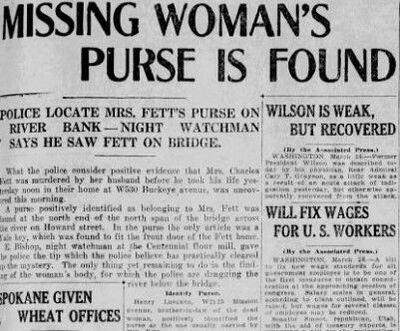This column reflects the opinion of the writer. Learn about the differences between a news story and an opinion column.
100 years ago in Spokane: Evidence was mounting that a businessman had murdered his wife to marry another

The evidence was growing that Mary Fett, missing for days, had been murdered by her husband.
A night watchman at the Centennial Flour Mill reported that he saw a man believed to be her husband, Charles E. Fett, at the north end of the Howard Street bridge in the wee hours of the morning. When police searched the area, they found a purse, positively identified as Mrs. Fett’s. A key in the purse fit the lock on her house.
Police considered this “positive evidence” that she had been murdered by her husband and that her body had been thrown in the river. Fett, a Spokane businessman, died by suicide the next day. He shot himself when police arrived at the house to question him about her disappearance.
Police also learned that Fett “desired to put his wife away and marry Miss Louise Gendreau,” an employee of the Palace department store where Fett worked. Gendreau told police that Fett lied when he told her that he had secured a divorce from his wife.
Fett had reported his wife’s disappearance himself, but had been vague about the details. Spokane’s captain of detectives said Fett’s story “didn’t ring true from the start.” He also did not believe that Mary Fett would deliberately abandon their 10-year-old daughter. That’s why police returned to question him later. He shot himself when police arrived at his house a second time.
“The only thing yet remaining to do is the finding of the woman’s body, for which the police are dragging the river below the bridge,” the Spokane Daily Chronicle wrote.